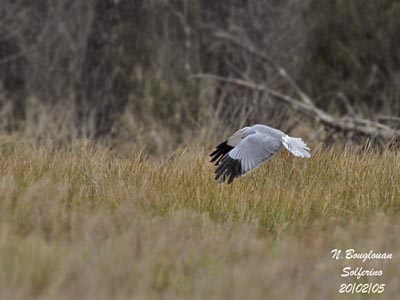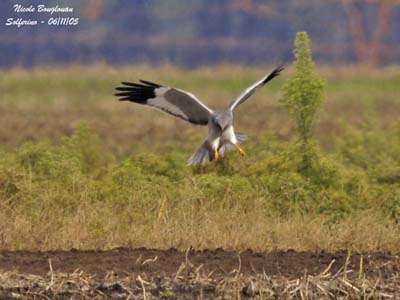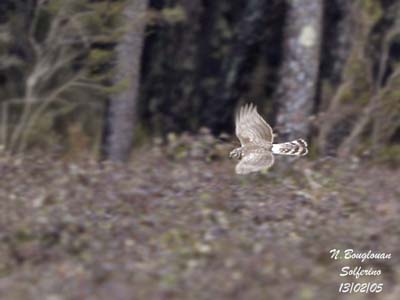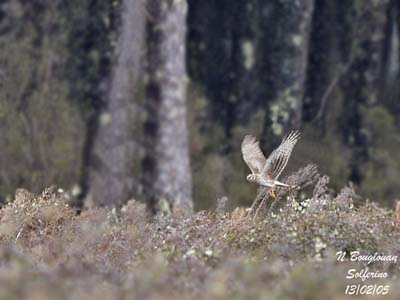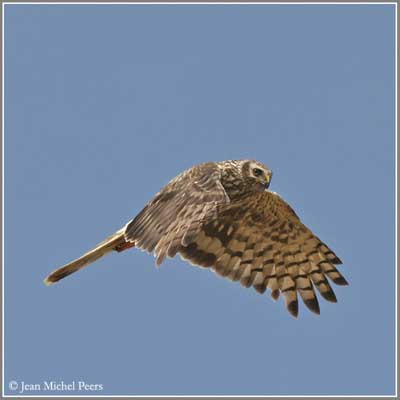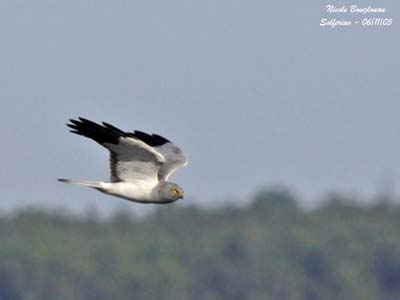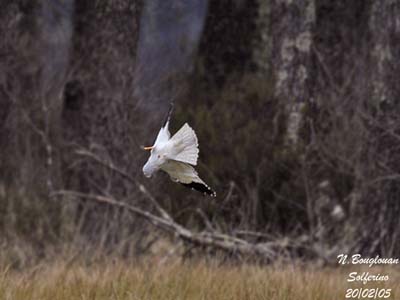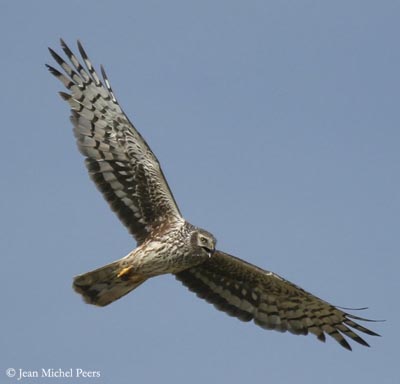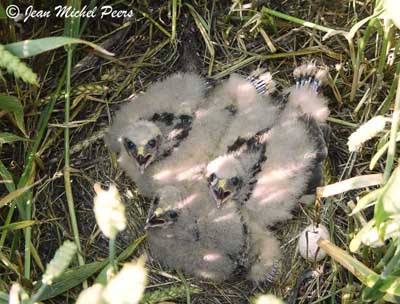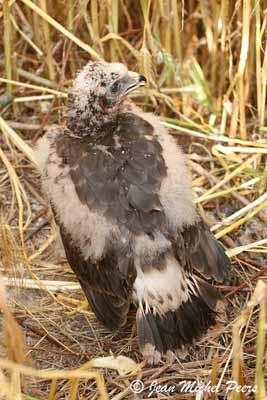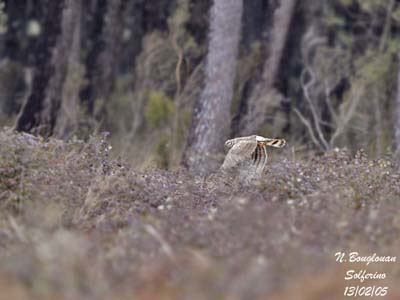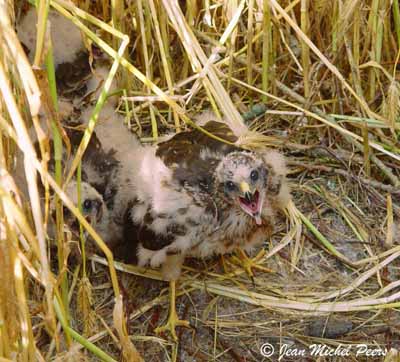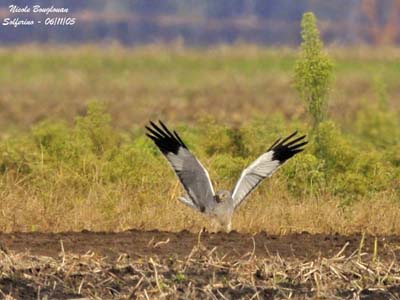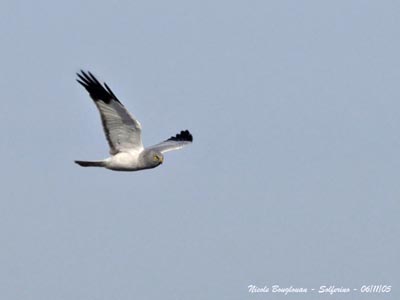
Hen Harrier
(Circus cyaneus cyaneus)
Accipitriforme Order – Accipitridae Family
Slender raptor with soft and finely shaded colours, the Hen Harrier, male or female, impresses by its beauty, its elegance, its pride and its bravery. I was filled with wonder by its behaviours, and I have only one desire, to see it again in order to observe it attentively, because I do not grow weary of this bird!
It would seem that its name is related to the arrival of the migratory birds in November, referring to Saint Martin, celebrated during this month…
It always arrives at the same hour, and practically at the same place. Its so pale plumage, light blue-grey on the upperparts, its darker grey head, the yellow legs contrasting with the plumage, and especially, these superb wings spreading their range of white feathers bordered with dusky trailing edge, and the conspicuous black wing-tips which rhythm its flapping on blue sky or pine forest background.
It is still high, and right before reaching the first pine-trees, it turns, flattens its wings with quite open black flight feathers, and soars for a moment, revealing the white rump. It is a Hen Harrier male, coming to explore the forest edge in search of food. What does it seek? Mainly small mammals, but also eggs, small birds, reptiles and crickets that also are what it needs!
It goes down gently to the thicket’s corner, and there, it rummages everywhere very low from the ground, skimming the undergrowth, plunging in a stump, coming out again to explore a rounded bush of which it follows the form while flying close to the branches. The show is attractive! No coppice escapes its research.
It follows quietly the forest edge, and sometimes alights with the talons forwards. And with this movement, I understand that it found a prey. It takes off very quickly and continues its game to the other thicket’s corner. And there, it rises slowly towards the treetops, touching it lightly, and disappears as abruptly as it appeared to me. I will not see it again today.
I return the following day of course, and I wait for it in the same area. Any surprise, but a great joy! At the usual hour, a raptor arrives lower, maybe almost heavier, but with similar behaviour to that of yesterday. It is the female! Its varied plumage blends in with the dry undergrowth. It is still the winter.
As the male, she follows the edge of the pines, flying over each bush, the head constantly turned downwards to seek her preys. Its body showing soft golden brown back and upperwings, slowly undulates just above the vegetation. Sometimes, the fanned tail reveals the pale, barred black rectrices, ending in narrow pale line. The white rump is the only similarity between the two partners.
Then, she raises the wings, forming a V, with hanging legs. Underparts are as beautiful as upperparts. Her broad, very pale chest is streaked with brown. The underwing reveals regular dark lines, barring the pale feathers. The wide open hand spreads out its long tipped dark flight feathers.
The harmony is perfect.
But the most surprising is her head. By seeing it, I immediately thought of a cat-like profile! The dark brown tinge of crown and nape shows a facial disc extending down to the throat. The very pale feather tips give this impression of streaks, drawing half-circles below the eyes and on the cheeks. The yellow and black bill and the piercing eyes give to this wonderful head the fine figure of the raptors.
Like the male, she forages along the edge of the pine forest, rises to the treetop, crosses the road, and disappears in her turn.
With the breeding season approaching, the male surpasses itself to seduce the female. Its flight display is spectacular. It climbs up vertically towards the sky where it performs a cabriole, and then, it drops with closed wings. The female is perched and seems to be quite unconcerned about him, while the male continues its displays.
It climbs up several times in the air, and dives towards the ground to still rise and make its cabriole, each time lower.
And abruptly, the female also flies away, very high, and joins the male. At this moment, a series of plays and disputes start while calling, they dive together towards the ground, and before to start a new rise, she turns onto her back and presents its talons to the male, but they will not touch each other.
The nest of this species is on the ground. When the nesting period starts, the female remains at nest and incubates the eggs. Its many-coloured plumage allows her to blend in quite with the environment. The male feeds her in a very special way. While approaching the nest, it utters a particular call which invites the female to meet it. They approach to each other, the male above the female. She approaches more, while turning towards him and calling him gently. At this moment, it releases its prey and she catches up immediately. Sometimes even, she grabs it from the male’s talons before it releases it. The operation usually never fails.
After one month of patience, the chicks hatch. Their body is covered with very white down, and the eyes are rimmed with brown. The male brings the skinned preys at nest, and the female feeds the young. At two months age, they perform their first flights with their parents. They seem to be very clumsy, but they learn quickly. They will remain together until the late summer, and will leave the parental territory together.
The Hen Harrier may be aggressive towards other harriers if they approach the territory and the nest site. When the chicks are at nest, if an intruder ventures too much close, both parents perform low flights, accompanied by squawking, in order to intimidate and to chase away the curious ones.
In the same way, the few days old chicks are strong enough to react if attacked. If a predator tries to seize them, they project their talons forwards and open widely the bill in a threatening way, while blowing very strongly. This attitude is often enough to discourage the visitors.
To sum up, the Hen Harrier is a graceful bird of prey, with interesting and original behaviour. He likes the shrubby areas, the forest edges and the open lands. During the winter, it may sleep at roosts gathering ten individuals, but it often spends the night alone on the ground.
I am impressed by so much beauty and precision. These raptors are endowed with a rare instinct and show grace and agility for our greater pleasure. I hope to see it again more and more, in order to observe carefully his attractive behaviours.
Pictures of female in flight in large view, and chicks at nest are taken by Jean Michel Peers.
His website: JMPN PHOTOGRAPHIE
Text and photographs by Nicole Bouglouan
Sources :
Observations personnelles sur le terrain
GUIDE DES RAPACES DIURNES – Europe, Afrique du Nord et Moyen-Orient de Benny Génsbol – Delachaux et Niestlé – ISBN : 2603013270
THE HANDBOOK OF BIRD IDENTIFICATION FOR EUROPE AND THE WESTERN PALEARCTIC by Mark Beaman, Steve Madge - C.Helm - ISBN: 0713639601
Wikipedia (Wikipedia, The Free Encyclopedia)
The Hawk Conservancy Trust (Hilary Smith)
Pájaros de España (JL Beamonte)
Animal Diversity Web - (University of Michigan Museum of Zoology)
Taken during a nest protection intervention in a cultivated field.
This is carried to avoid predators to destroy the brood and help the farmer locating the nest in case of an early harvest.
Action monitored by the LPO (Ligue de Protection des Oiseaux)

